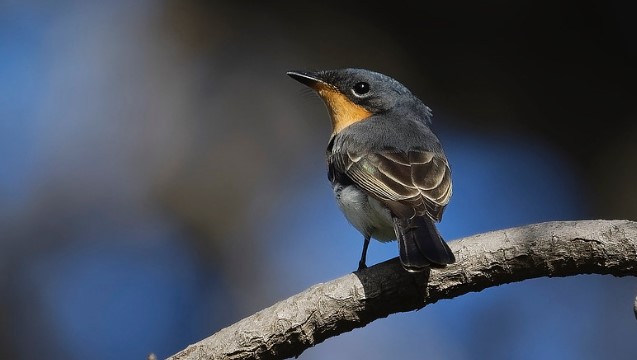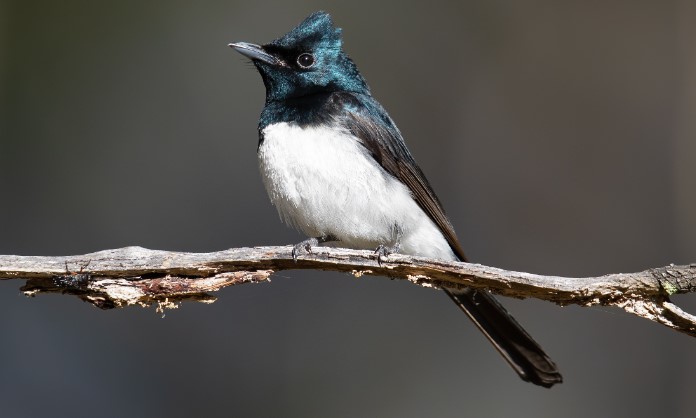Behavior & Habitats: Satin Flycatcher (Myiagra cyanoleuca) is darker, larger, and longer-tailed than the similar-looking Leaden Flycatcher (Myiagra rubecula). Breeding and foraging take place in taller, wetter eucalypt forests of coastal southeastern Australia, both on rolling plains and in steep mountain gullies. As a result, the rainforest is avoided.
There are two to five pairs of Satin Flycatchers that nest 20-50 meters apart in loose colonies. Both sexes build the nest, incubate, and feed their young; they sometimes feign injury and dart along the ground, diverting attention from the nest. There is usually only one brood per season. After fledging, parents and young move to drier, more open forests not used for breeding to forage.
Family: Satin flycatchers belong to the Monarchidae family.
Feeding Habits: Invertebrates (insects) are caught with their small, sharp, pointed beaks. Throughout the forest’s upper strata, they feed singly or in dispersed pairs. They are constantly moving. Birds catch their food on the wing, either midair or among upper foliage when they make short, dashing sallies out of a perch, usually a small horizontal twig underneath the forest canopy. The diet consists of grasshoppers, beetles, blowflies, crane flies, moths, and long-tailed wasps. Their short stays on perches are punctuated by constant tail quivering, crest raising, and a constant call. Upon landing, the tail sways from side to side.
Call: A Satin Flycatcher makes a single guttural, strident call, a zurrrp or a bzzurtt, by either sex. At regular intervals, the call is repeated.
Song: A satin flycatcher’s song is a loud and clear whistle with two syllables, with the second syllable rising as it is repeated repeatedly.
Alternative names: It is also known as the Satin Sparrow or the Shining Flycatcher.
Size: The size of the Satin Flycatcher is about 170-180 mm in length and weighs around 17g.
Read More – Purple-crowned Fairywren (Malurus coronatus)
Identification: Sexually dimorphic characteristics are present in the species. Both sexes have an erectile sub-crest.
Male: The head, upper parts of the wings, and tail, as well as the throat and upper breast, are glossy blue-black. From the lower breast to the undertail, the color is pure white. The eyes are a black-brown color. The bill is deep blue-grey with a black tip. The feet are black.
Female: Dusky blue-grey head and nape with faint black gloss, pale eye-ring. Lower parts, wings, and tail duller blue-grey, flight feathers browner. A deep ochreish color covers the throat and upper breast; a pure white covers the rest of the underparts to the undertail.
Immatures: As a female, An immature bird’s back is duller and browner, while an adult male’s plumage is mottled due to patchy molting. The bill of juveniles is browner, flecked with gray over the ventral surface. Juveniles are duller than adults.
Migration: The Satin Flycatcher, which breeds from the Calliope Range, Queensland, southwards to Tasmania, is a strict migrant. It travels to northeastern Queensland, then crosses Torres Strait and winters in southern and eastern New Guinea. Traveling in ones and twos through the treetops, perhaps at night, they move north in March-April and return in September-October.
Nest & Breed: The nesting and breeding seasons occur in September or October-November to January-February. Nest is a broadly based cup of finely shredded bark fiber and grass, tightly coated with cobwebs and occasionally decorated with lichen; inside about 50 x 31 mm, lined with rootlets, hair, and shredded fiber; usually placed on a horizontal fork of a dead or near-dead bare branch, 3-25 meters above ground, where it blends well with foliaged branches. Brush Cuckoos and sometimes Pallid, Horsfield’s, and Golden Bronze-Cuckoos parasitize nests.
Eggs: There are usually three eggs laid by the bird, which are white to pale blueish green and spotted and freckled with grey-browns and purple-grey in the large end. The eggs are oval-shaped and measure approximately 20 x 16 millimeters. The incubation period is about 16-17 days for both sexes. It takes about 18 days for the young to fledge.
Distribution: The Satin Flycatcher lives in tall wet eucalypt forests on the coasts, plains, and tablelands of eastern Australia. The species breeds from Queensland’s Blackdown Tableland south to Tasmania and western Victoria. It migrates to the Cape York Peninsula and southeastern New Guinea, as well as to the surrounding islands; it vagrants to Western Australia and New Zealand.
Races: There are no races that exist.
Read More – Collared Flycatcher (Ficedula albicollis)











